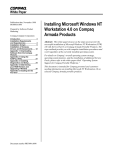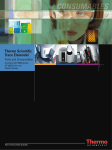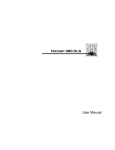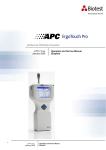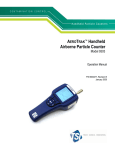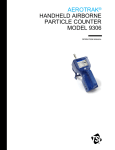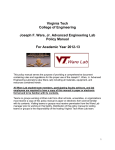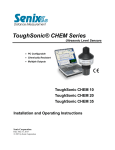Download DRAFT CETAC ASX-560 Autosampler Service Manual
Transcript
ASX-560 Autosampler Service Manual Manual Part Number 480218 Draft 0 COPYRIGHT TRADEMARK ACKNOWLEDGEMENTS © 2015 Teledyne Technologies Incorporated. All rights reserved. Windows is a registered trademark of Microsoft Corporation in the United States and other countries. 480218 Draft 0 , June, 2015 Teledyne CETAC Technologies authorizes its customers to reproduce, transmit, or store this document in its entirety, including this page, for the express purpose of installing, operating, or maintaining the product described herein. Teledyne CETAC Technologies Customer Service & Support 14306 Industrial Road Omaha, Nebraska 68144, USA Phone (800) 369-2822 (USA only) Phone (402) 733-2829 Fax (402) 733-1932 E-mail [email protected] REVISIONS Teledyne CETAC Technologies strives to provide the scientific community with an unparalleled combination of effective technology and continuing value. Modular upgrades for existing instruments will continue to be a prime consideration as designs progress. Teledyne CETAC Technologies reserves the right to revise this document and improve products described herein at any time without notice or obligation. PharMed and Tygon are registered trademarks of Saint-Gobain Performance Plastics. DuPont™, Kapton®, Teflon®, Tefzel® and Viton® are trademarks or registered trademarks of E.I. du Pont de Nemours and Company. Superthane is a registered trademark of NewAge Industries, Inc. KYNAR® is a registered trademark of Arkema Inc. KIMWIPES is a registered trademark and KIMTECH SCIENCE is a trademark of Kimberly-Clark Worldwide, Inc Super Lube is a registered trademark of SYNCO Chemical Corporation. All other marks are the property of their respective owners. Contents 1 Introduction ..............................................................................................................5 2 About This Manual ................................................................................................................ 5 Who Should Read This Book...................................................................................... 5 Important Safety Precautions................................................................................... 5 General Precautions for Protecting the Autosampler ..................................... 6 Repair Strategy ....................................................................................................................... 6 External Parts Identification............................................................................................. 7 List of Replaceable Parts ..................................................................................................10 How to Obtain Spare Parts ..............................................................................................11 Setting Up a Service Area .................................................................................................11 Recommended Service Tools .........................................................................................11 General Tips and Tricks ....................................................................................................12 Returning the Product to CETAC ..................................................................................12 Shipping the Product ..................................................................................................12 Where to Go for More Information..............................................................................13 3 Cleaning the Autosampler................................................................................................15 Replacing the Z-Drive ........................................................................................................16 How Does the Z-Drive Work?...................................................................................16 How Should I Care for the Z-Drive?.......................................................................17 Removing the Old Z-Drive.........................................................................................17 Installing the New Z-Drive .......................................................................................18 Replacing the Home Flag/Guide Plate........................................................................22 Basic Maintenance ............................................................................................... 15 Troubleshooting the Autosampler ................................................................ 23 Summary of Common Problems ...................................................................................23 Power System Problems...................................................................................................24 Communications Interface Problems .........................................................................25 RS-232 Serial Cable Problems.................................................................................25 USB Cable Problems....................................................................................................25 Software Configuration Problems.........................................................................26 Z-Drive Problems.................................................................................................................26 Contamination and Carryover Problems ..................................................................28 Using the C-Term™ Terminal Program ......................................................................28 3 ASX-560 Autosampler Operator’s Manual – DRAFT Contents Starting C-Term ........................................................................................................... 29 Overview of the C-Term Window........................................................................... 29 Configuring C-Term .................................................................................................... 29 Autosampler Commands........................................................................................... 30 4 Disassembling the Autosampler .....................................................................31 5 Remove the Tray..................................................................................................................31 Remove the Z-Drive............................................................................................................31 Remove the Cover ...............................................................................................................32 Remove the Splash Shield................................................................................................32 Remove the Base..................................................................................................................33 Remove the Left Endplate ...............................................................................................34 Remove the X Drive Assembly.......................................................................................36 Disassemble the X Drive Assembly/ Carriage ........................................................39 Remove the Y Arm from the Carriage ........................................................................41 Remove the Motor from the Carriage.........................................................................42 Remove the Sensors ...........................................................................................................42 Remove the E-Chain ...........................................................................................................43 Repair Procedures ...............................................................................................45 6 Replacing the Pump............................................................................................................45 Replacing the Rotor/Stator.............................................................................................46 Replacing the Z Axis Motor .............................................................................................48 Replacing the Crash Block ...............................................................................................48 Replacing the X Axis Drive Belt .....................................................................................49 Replacing the USB Port .....................................................................................................52 Replacing the Main Circuit Board ................................................................................53 Diagrams..................................................................................................................55 Wire Routing and Cable Connections.........................................................................55 Power/Serial Cable..................................................................................................... 55 Motors/Home Sensors/LED/Pump ...................................................................... 56 E-Chain ............................................................................................................................ 56 4 1 Introduction About This Manual This manual describes the procedures for repairing the CETAC ASX-560 autosampler. Who Should Read This Book This manual is intended for use by customers who have experience repairing laboratory equipment and by service technicians at CETAC-authorized service centers. Performing repairs or modifications beyond the ones described in this manual may void the warranty on the instrument. Important Safety Precautions WARNING WARNING SHOCK AND MECHANICAL INJURY HAZARDS The Operator’s Manual contains safety-related information which is not repeated in this Service Manual. The Operator’s Manual is supplied on the CD with the autosampler. It may also be downloaded from www.cetac.com. If you need safety information in a language other than English, refer to the included Autosampler Safety Manual. SHOCK HAZARD Ensure the power cord is turned off and disconnected before touching the autosampler or opening any protective covers. Replace all covers and guards before reconnecting power. 5 ASX-560 Autosampler Operator’s Manual Chapter 1: Introduction WARNING CHEMICAL INJURY HAZARD The autosampler may have been contaminated with hazardous materials. Make sure you know about any materials which may have contaminated the autosampler, and take precautions appropriate for the hazards associated with those materials. Exposure to laboratory chemicals may result in serious injury. General Precautions for Protecting the Autosampler CAUTION CAUTION CAUTION Static Discharge Discharge static buildup and ground to the autosampler base or cabinet before performing any maintenance. Do not touch or short-circuit the contacts on the communication ports. Moving the Z-Drive Do not allow the cable to bend sharply. Avoid pushing up on the slider or pushing on the Z-drive cable. Move the Z-drive by rotating the rotor on the back of the autosampler. Do not move the Z-drive or sample probe directly as damage to the drive cable may result. Lubrication Never lubricate the autosampler. Oil or other lubricants will accumulate contaminants and cause the moving parts to bind. NOTE To prevent contamination, wear gloves when handling the probe or other surfaces which may come in contact with samples. Repair Strategy In general, the repair strategy for this product is board replacement or mechanical assembly replacement. Circuits are protected by a conformal coating, so component-level repair of the circuit boards is strongly discouraged. 6 ASX-560 Autosamplers Service Manual Chapter 1: Introduction External Parts Identification Z X Z-Drive Assembly Y Power Indicator Lamp Rinse Station Arm Head Base Sample Vial Racks Sample Tray Figure 1-1 ASX-560 Autosampler—Front View The following components are located on the front of the autosampler and are shipped with the autosampler (see Figure 1-1). Sample Tray. The sample tray holds the rinse station, sample racks, and standards vials in place. The tray also contains small spills. Standards Vials. Rinse Station. Arm. The arm moves the sample probe horizontally. Sample Vial Racks. Z-Drive. The Z-drive moves the sample probe vertically. The Z-drive assembly includes a Y-axis slider block and guide plate as well as the sample probe. The Z-drive attaches onto the autosampler arm. Power Indicator Lamp. The LED indicates that the autosampler is connected to a power source and turned on. 7 ASX-560 Autosampler Operator’s Manual Chapter 1: Introduction Guide Block Power Switch Serial Ports USB Port Access Cover for Auxiliary Connector Peristaltic Pump Power Connector Z-Drive Rotor Figure 1-2 ASX-560 Autosampler—Back View The following components are located on the back of the autosampler and are shipped with the autosampler. On-board peristaltic pump. Serial Ports. The COM1 port connects the autosampler with the analytical instrument’s host computer. The COM2 port connects the autosampler to other external devices, such as an autodilutor. 8 USB Port. The USB port can be used to interface the autosampler with the host computer. ASX-560 Autosamplers Service Manual Chapter 1: Introduction Spiral Wrap Sleeve (Protects Z-Drive Cable) Z-Axis Slider Y-Axis Slider Block Home Flag Nut Z-Drive Cable Figure 1-3 ASX-560 Autosampler—Z-Drive Assembly 9 ASX-560 Autosampler Operator’s Manual Chapter 1: Introduction List of Replaceable Parts Difficulty levels are defined as: Easy – The part can be replaced by the user with no special training. Minimal disassembly is required. Advanced – The part can be replaced by users who are confident in their electrical and mechanical repair skills. Some procedures require good manual dexterity and the use of special tools. Factory – The autosampler should be returned to Teledyne CETAC Technologies for repair. Custom-made tools or specific adhesives may be required, or the procedure may be especially complex or errorprone. Part numbers and availability are subject to change without notice. See the Spare Parts and Accessories Catalog for the latest list of spare part numbers. Part Number Description Difficulty Level Where to Find Service Instructions SP6103 24-Volt Power Supply Easy Operator’s Manual SP7448 Arm Tube Assembly Advanced Page 41 SP7456 Base Plate Easy Page 33 Bearings, X-Axis Leadscrew Advanced Page 39 SP7453 Bearings, X-Axis linear Advanced Page 39 Various Carbon Fiber Sample Probes Easy Operator’s Manual Various Front Cover Easy Page 32 SP7451 Guide Shaft Advanced Page 39 SP7460 LED Assy Factory SP7452 Main Board Advanced Page 53 Peristaltic Pump Shoe (Roller Band) Easy Operator’s Manual Various Peristaltic Pump Tubing Easy Operator’s Manual SP7443 Power Switch Advanced Power/RS-232 Cable Assy Factory SP7440 Pump Motor Kit - 2 Channel Advanced Home 45 SP7457 Rinse Station Easy Operator’s Manual Various Rinse/Drain Tubing Easy Operator’s Manual SP7438 Rotor Assembly Advanced Page 46 SP7439 Tray Assembly with 10 Standards Positions Easy Operator’s Manual USB Cable Assy Factory SP7475 USB Connector, internal Advanced Page 52 SP5222 X Axis Drive Belt Advanced Page 49 SP7450 X Axis Lead Screw Kit Advanced Page 39 SP7444 X/Y/Z/Crash Sensor Advanced Page 42 (X/Y), Page 46 (Z) 10 ASX-560 Autosamplers Service Manual Chapter 1: Introduction SP7445 X-Axis Stepper Motor Advanced Page 49 SP7442 Y Axis Cable Assembly (E-Chain) Advanced Page 43 SP7449 Y Axis Lead Screw Kit Advanced Page 41 SP7458 Y Home Flag - w/ probe guide Easy Page 22 & Operator’s Manual SP7459 Y Home Flag - w/o probe guide Easy Page 22 & Operator’s Manual SP7446 Y-Axis Stepper Motor Advanced Page 42 SP7437 Z Axis Drive Assembly Easy Page 16, Instructions are also supplied with part SP7174 Z Axis Tubing Replacement Kit Easy Instructions with part SP7447 Z-Axis Stepper Motor Advanced Page 48 How to Obtain Spare Parts To see what parts are available, refer to the Spare Parts and Accessories Catalog available from CETAC. It is recommended to order parts by telephone, so you can discuss your particular needs. Setting Up a Service Area The work surface should meet the same space requirements as specified for the laboratory in the Operator’s Manual. An ESD work surface is recommended. Recommended Service Tools Laboratory gloves to prevent personal exposure to hazardous substances and to prevent contamination of equipment which may come in contact with samples. Protective eyewear Other personal protective equipment (as needed for protection from hazardous materials which may have contaminated the autosampler) ESD wrist strap Set of slotted screwdrivers Short-handled slotted screwdriver Set of Phillips screwdrivers Set of hex keys or Allen wrenches (English measurements) Gear puller (approximately 1-1.5 inch/2-4 cm) 11 ASX-560 Autosampler Operator’s Manual Chapter 1: Introduction Lint-free laboratory wipers such as KIMTECH SCIENCE™ KIMWIPES® Delicate Task Wipers. PTFE lubricant (Super Lube® multi-purpose synthetic grease or equivalent) LOCTITE® Threadlocker Blue 242® or equivalent Plastic wire ties Clean paintbrush (for brushing away dust) Large sink or tub (for washing the sample tray) Laboratory-grade cleaning agents PC with at least one free USB port and at least one free serial port Voltmeter General Tips and Tricks Use the standards tray to organize small parts as which have been removed from the autosampler. Tighten KYNAR® thumbscrews using only your fingers (never use pliers). Do not lubricate the lead screws. Lubricants of any type may lead to fouling, sample contamination, and increased friction. Returning the Product to CETAC Refer to the following information if you need to return the product to Teledyne CETAC Technologies for service. Shipping the Product Follow these guidelines when shipping the product: Do not return products which are contaminated by radioactive materials, infectious agents, or other materials constituting health hazards to CETAC employees. Use the original packing materials. If the original shipping materials are not available, place a generous amount of shock-absorbing material around the instrument and place it in a box that does not allow movement during shipping. Seal the box securely. Contact Teledyne CETAC Technologies before shipping the product. Pre-pay all shipping expenses including adequate insurance. Write the following information on a tag and attach it to the product: 12 Name and address of the owner Product model number and serial number Description of service required or failure indications ASX-560 Autosamplers Service Manual Chapter 1: Introduction Mark the shipping container as FRAGILE. In all correspondence, refer to the instrument by model name or number and full serial number. Where to Go for More Information NOTE This service manual is not intended to stand alone. You will need to refer to information in other documents—especially the Operator’s Manual and the Spare Parts and Accessories Catalog. In addition to this manual, you can refer to the following resources: New versions of this manual may be available under “Service and Support” on CETAC’s Web site: www.cetac.com ASX-560 Autosampler Operator’s Manual, available on the CETAC Web site and on the CD which comes with the autosampler. ASX-560 Autosampler Spare Parts and Accessories Catalog, available on the CETAC Web site. CETAC Autosampler Safety Guide provides basic safety-related information in a variety of languages. Online help within the ASX Dashboard software. Teledyne CETAC Technologies Customer Service and Support: Phone: 1 (800) 369-2822 (USA only) 1 (402) 733-2829 Fax: 1 (402) 733-1932 E-mail: [email protected] 13 2 Basic Maintenance Many routine maintenance tasks are described in the Operator’s Manual and are not repeated in this Service Manual. Those tasks include: Checking for Leaks Replacing Peristaltic Pump Tubing Setting the Z-Axis Travel Replacing the Z-Drive Replacing the Rinse Station Replacing the Sample Tray Cleaning the Autosampler WARNING CAUTION CAUTION Use of the autosampler often results in spills on autosampler components such as the sample tray. To avoid spreading contamination which could cause injury or equipment damage, it is a good practice to thoroughly clean the exposed surfaces before performing repairs. SHOCK HAZARD Do not allow any liquid to enter the instrument cabinet other than as intended through the specified tubing, or come into contact with any electrical components. The instrument must be thoroughly dry before you reconnect power, or turn the instrument on. Do not allow the cleaning agent to come into contact with the lead screws. Also, never lubricate either of the two lead screws. Do not clean with carbon tetrachloride. 15 ASX-560 Autosampler Operator’s Manual Chapter 2: Basic Maintenance 1 2 3 Shut down and unplug the autosampler. Remove the sample tray. Wipe loose particles off the Y-axis lead screw with a dry, lint-free cloth. The Y-axis lead screw is the large metal screw located inside the autosampler arm. Figure 2-1 Y-Axis Lead Screw Never lubricate the lead screws. The lead screw nuts are compounded with a dry film lubricant which is intended to be used without additional lubricants. Oiling the lead screws will cause gumming, galling, and binding of the moving parts. CAUTION 4 5 Wipe the autosampler exterior and base until they are clean, using a towel dampened with a lab-grade cleaning agent, followed by a towel dampened with clear water. Pay special attention to the Y-axis slider block and the autosampler arm. Wash the sample tray in a warm detergent solution. 6 Make sure you remove all spills and stains. 7 Ensure that the sample tray is thoroughly dry. Rinse the sample tray with water and then dry it. Replace the sample tray on the autosampler base. Replacing the Z-Drive These instructions assume you are installing a new, standard-model Z-drive. How Does the Z-Drive Work? The Z-drive is driven by a length of cable. A rotor on the back of the autosampler moves the cable, which slides the probe up and down on the Zdrive. A mounting block on the back of the autosampler pivots back and forth to allow free motion of the cable while preventing the cable from kinking. 16 ASX-560 Autosamplers Service Manual Chapter 2: Basic Maintenance Spiral Wrap Sleeve (Protects Z-Drive Cable) Z-Axis Slider Y-Axis Slider Block Home Flag Nut Z-Drive Cable How Should I Care for the Z-Drive? Do not allow the cable to bend sharply. Avoid pushing up on the slider or pushing on the Z-drive cable. CAUTION Do not tighten the thumbscrews or nuts with anything other than your fingers. Removing the Old Z-Drive 1 2 3 Place the autosampler on a flat surface and turn the unit off. Remove the two thumbscrews from the Y-axis slider block. Remove the cable from the rotor by loosening the thumbscrew on the rotor and also removing the two thumbscrews from the guide block. Remove the old Z-drive from the arm by pulling the whole Z-drive forward and off the autosampler arm. 17 ASX-560 Autosampler Operator’s Manual Chapter 2: Basic Maintenance Installing the New Z-Drive 1 2 Remove Z-drive from the bag. 3 Figure 2-2 Sliding the Z-Drive Onto the Arm Slide the Z-drive onto the y-arm until the two holes in the Y-axis slider block align with the matching holes in the Y-axis carriage. Secure the Z-drive to the carriage using the two thumbscrews. Tighten the thumbscrews using your fingers. Figure 2-3 Securing Z-Drive Onto the Arm 18 ASX-560 Autosamplers Service Manual Chapter 2: Basic Maintenance 4 5 6 Feed the cable through the rear guide block and around the rotor, then tighten the nut to secure the cable sleeve to the guide block. Figure 2-4 Guide Block with Nut Turn the rotor clockwise as far as it will go. Finish sliding the cable around the rotor on the back of the autosampler. Loosen the thumbscrew on the rotor to allow the cable to pass through the clamp, with about 2 mm of cable extending past the clamp. Figure 2-5 Position of Cable on Rotor 19 ASX-560 Autosampler Operator’s Manual Chapter 2: Basic Maintenance 7 8 Verify that there is a small gap between the Z-axis slider and cap at the top of the Z-drive (approximately 1-3 mm). Adjust the cable a bit if necessary. Figure 2-6 Sample Probe at Top Position With Gap Hold the cable flat against the rotor and secure the cable by tightening thumbscrew on the rotor. The thumbscrew should be as tight as possible using just your fingers. Figure 2-7 Securing Cable to Rotor The cable is pre-cut to the proper length and does not need to be trimmed when properly installed. 20 ASX-560 Autosamplers Service Manual Chapter 2: Basic Maintenance 9 CAUTION Rotate the rotor back and forth to ensure that it moves freely. If there is excessive friction, check that the full width of the cable is under the clamp. Also check that the end of the cable is not rubbing on the shroud around the rotor. Never push the Z-axis slider to move it up or down. Pushing on the Z-axis slider can kink the drive cable. Instead, rotate the Z-drive rotor on the back of the autosampler. Z-Drive Rotate to Move the Z-Drive Figure 2-8 Z-Drive Rotor 10 Install a sample probe. 11 Use the utility software to align the probe over the rinse station. 12 Use the utility or your instrument control software to move the probe to several rack positions to make sure the probe is hitting positions correctly. 21 ASX-560 Autosampler Operator’s Manual Chapter 2: Basic Maintenance Replacing the Home Flag/Guide Plate The autosampler uses a Y-axis home position flag to verify that the Z-drive is fully in the home position (over the rinse station). Some applications use a version of this part which also extends forward to provide a guide plate for the sample probe. 1 2 3 4 The home flag can be replaced if it is damaged. You will need a short-handled slotted screwdriver. Shut down and unplug the autosampler. Remove the screw. Replace the home flag. Replace the screw. The home flag does not need to be adjusted or trimmed. Screw Home Flag Figure 2-9 Home Flag 22 3 Troubleshooting the Autosampler In the event that the product does not function properly, isolate the problem to determine if it originates in the host computer, the analytical instrument, or the autosampler. This chapter explains how to troubleshoot autosampler problems. If you cannot solve a problem using the steps given in this chapter, you should contact Teledyne CETAC Technologies Customer Service and Support. Summary of Common Problems Problem Possible Cause Solution Autosampler does not initialize AC Power Cord or DC power cord not connected. Plug AC power cord firmly into wall plug and into desktop power supply. Power LED is not illuminated. Plug DC power cord firmly into plug at back of cabinet. RS-232 or USB cable not connected or connected properly. Reconnect cable. Make RS232 and USB are not connected at the same time. Correct "COM" port is not selected. Use C-Term to verify correct COM port. Autosampler does not move when commanded. Verify that ICP program uses same COM port. Download and run CETAC test software from www.cetac.com. Power supply LED flashes when autosampler power is turned on. Possible short on main control board. Contact CETAC. 23 ASX-560 Autosampler Operator’s Manual Chapter 3: Troubleshooting the Autosampler Axis does not "Home" after power has been applied PIC for that axis did not initialize properly. Turn off autosampler power, wait 30 seconds, and turn on power. "Home" sensor for that axis is not working. Connect digital voltmeter (DVM) to sensor output and manually move axis to and from home position. A 4VDC change should be detected. Axis tries to keep moving after reaching "Home" position. "Home" sensor for that axis is not working. Connect DVM to sensor output and manually move axis to and from home position. A 4VDC change should be detected. No movement in X direction X axis belt is not properly on Open the unit. Make sure that on the right side of the unit the belt is on the leadscrew and the X motor sprockets. Z axis chatters when the system is turned on Z drive is misaligned Refer to the Operator's Manual for Z-drive assembly installation Power System Problems 1 A possible cause of system malfunction is a problem in the power system. If the system is not functional, it is possible that it is not receiving power. If this is the case, the LED power indicator light on the autosampler will be off. To troubleshoot this problem, complete the following steps in sequence until the problem is solved: 2 Check that the power switch on the autosampler is turned on. 3 If the cable is plugged in, ensure that it is not damaged in any way. Check that the power cord is plugged in firmly between the power input on the autosampler and the external power supply and also between the power supply and the wall outlet. Check that the LED on the power supply is illuminated. If the LED is not illuminated, check the wall outlet using a device approved for that purpose. If the wall outlet is working and the voltage is acceptable, unplug the external power supply from the autosampler, but leave it plugged into the wall. 24 If the LED is not lit, the power supply is faulty and requires replacement. ASX-560 Autosamplers Service Manual Chapter 3: Troubleshooting the Autosampler 4 5 If the LED is lit when unplugged from the autosampler but turns off when plugged into the autosampler, the autosampler may have an internal short and requires repair. Check the wall outlet. If the external power supply LED is illuminated while plugged into the autosampler, cycle the autosampler power switch. The autosampler sample probe should move up and the autosampler should initialize. After initialization, the power LED on the front of the autosampler should light up. If the cords are properly connected, power is available, the external power supply is good, and the unit still does not initiate, continue troubleshooting. Communications Interface Problems Operation of the autosampler is directed by the host computer. A malfunction can indicate a problem with the RS-232 or USB cable (connected between the host computer and the autosampler) or with the configuration of the software on the host computer. The following sections explain how to troubleshoot these problems. RS-232 Serial Cable Problems 1 Check the RS-232 cable to ensure it is plugged in to the COM1 port on the autosampler. If the cable is plugged in, ensure that it is tightened properly and not damaged in any way. 2 Note that the cable must be plugged into the COM1 port, not the COM2 port. 3 If the cable is plugged in, ensure that it is tightened properly and not damaged in any way. Check the host computer to ensure that the RS-232 cable is connected to the appropriate COM port. Check the serial port settings (9600, N, 8, 1). If the wrong port or baud rate is selected, change the configuration. USB Cable Problems Either RS-232 or USB may be used, but not both at once. 25 ASX-560 Autosampler Operator’s Manual Chapter 3: Troubleshooting the Autosampler 1 2 Check that the USB cable to ensure it is plugged into the port on the autosampler. 3 Note that if you move the USB cable to a different USB port, the driver may assign a new COM port number. 4 Check the host computer to ensure that the USB cable is connected to the appropriate USB port. Check that the USB cable is not damaged in any way. Check the host computer to ensure that the USB drivers are installed for USB operation of the autosampler. Load the proper USB drivers to the host computer from the CD that was provided with the autosampler. Software Configuration Problems 1 If the communication cable is connected properly and the system is still not functioning with the instrument control software, ensure that the software is communicating correctly with the autosampler. To do so, use the supplied ASX Dashboard software. 2 Connect to the autosampler using the Autosampler IQ-OQ utility which in the ASX Dashboard. 3 If the commands have no effect, and a USB connection is being used, check that the autosampler is plugged into the same USB port as it was when the driver software was configured. Unlike many consumer devices, each USB port used as a “virtual” COM port must be individually configured. Toggle the pump on and off.. If manual controls work, but the autosampler does not operate with the instrument control software, carefully check that the software is configured to use the COM port where the autosampler is plugged in. If a USB connection is used, and if the manual commands work, but the instrument control software fails to operate the autosampler, check that the same COM port number is configured in the software and in the USB device driver. Z-Drive Problems An autosampler malfunction may be caused by a problem in the Z-drive assembly. You can easily determine that a malfunction is related to the Z-drive if you hear a loud chattering noise when the autosampler power switch is on or if the sample probe is not moving. To troubleshoot Z-drive problems, complete the following steps: 26 ASX-560 Autosamplers Service Manual Chapter 3: Troubleshooting the Autosampler 1 2 Ensure that the Z-drive is installed correctly. Check the Y-axis home position flag. When the Z-drive returns to the home position, the flag should enter the corresponding slot. 3 If the flag is damaged, replace it. Ensure the sample probe is moving freely. Gently rotate the rotor on the back of the autosampler to move the sample probe up and down. If the sample probe is binding, free the sample probe assembly. NOTE: If you cannot free the Z-drive, you will need to replace it. See page 16 for information about mounting a new Z-drive. You can order a new Z-drive from Teledyne CETAC Technologies. 4 Inspect the Z-drive cable for sharp bends, kinks, or rough spots. If the cable is damaged, replace the Z-drive. 27 ASX-560 Autosampler Operator’s Manual Chapter 3: Troubleshooting the Autosampler Contamination and Carryover Problems 1 2 3 4 5 6 Check the rinse station tubing. Rinse solution should flow upward from the bottom of the rinse station. Check the end of the rinse solution drain tube. It should be above the surface of the liquid in the waste container. If recycling the rinse solution, check whether the rinse solution needs to be changed. Examine the sample transfer tubing. Make sure that it is as short as possible while still free to move. Make sure that there are no unnecessary fittings on the sample transfer tubing—fittings can create small reservoirs where contaminants can hide. Watch for liquid dripping from the sample probe as it moves. It may be necessary to slow the autosampler down to reduce droplet shedding. This can be adjusted using the Speed Shift utility in the ASX Dashboard software. Check that the sample probe remains in the rinse station long enough. This can be adjusted using the Speed Shift utility. Using the C-Term™ Terminal Program The autosampler can be controlled by sending it simple commands. This can be helpful for troubleshooting. You can use any terminal emulation program. This chapter explains how to operate a CETAC autosampler using the C-Term terminal program, which is provided on the software CD. C-Term is a simple terminal program developed to validate the installation and functionality of various CETAC devices. C-Term communicates through a serial (RS-232) port on the host computer. If the autosampler is connected to a USB port, the device driver will create a virtual serial port. 28 ASX-560 Autosamplers Service Manual Chapter 3: Troubleshooting the Autosampler Starting C-Term 1 2 3 Check that the autosampler is connected to the PC. Close any programs which might be communicating with the autosampler. On the Start Menu, click All Programs | Teledyne CETAC Technologies | Support Tools | C-Term. Overview of the C-Term Window Copy Paste Clear Terminal Buffer Disconnect Connect COM Port & Status Baud Rate Figure 3-1 C-Term Window Commands typed in this window are sent to the CETAC device connected to the opened port. The typed commands will appear in light green in the terminal buffer. Responses from the autosampler will appear in red. Non-printing characters such as carriage returns will appear as ASCII hexadecimal numbers surrounded by square brackets; for example, [0D] is the carriage return character. Configuring C-Term 1 2 By default, C-Term attempts to open COM1 the first time it is executed. If the autosampler is connected to another COM port, configure C-Term to use the desired port. On the Tools menu, click Setup Serial Port. Select the desired COM port and click OK. NOTE The autosampler communicates at 9600 baud (which is the default.) Only installed COM ports, including USB virtual COM ports, will appear in the Comm Port menu. 29 ASX-560 Autosampler Operator’s Manual Chapter 3: Troubleshooting the Autosampler Autosampler Commands The following commands are helpful for verifying autosampler operation. This is not a comprehensive list of commands. CAUTION Command VER Returns firmware version. HOME Returns probe to home position. ABS=x-y-z Moves to position defined in steps of 0.1 mm from the home position. Example: ABS=1000-1000-0 moves to X=100 mm, Y=100 mm, Z=top. PMP ON Turn the peristaltic pump on. PMP OFF Turn the peristaltic pump off. RINSE Moves probe to the rinse position, extends and retracts the probe 3 times and starts rinse pump. Stays in down position with pump running. UP,PMP OFF stops the pump. DOWN=n Moves the z-axis down by n mm. UP Moves z-axis to the top position. Table 3-1 Autosampler Commands Description Make sure that there is enough space for the probe to move. Equipment damage can occur if the probe collides with an obstruction such as a vial or rack. 30 4 Disassembling the Autosampler This chapter presents a suggested sequence for disassembling the autosampler in order to reach its internal components. NOTE In most cases, complete disassembly is not necessary. You only need to perform as many steps as are required to access the part you are replacing. Remove the Tray Simply lift the tray from the base. Remove the Z-Drive 1 2 3 4 Removing the Z-drive reduces the chance of accidental damage and allows you to remove the cover from the autosampler. Reverse the steps in “Replacing the Z-Drive” beginning on page 16. Loosen the nut on the crash block. Loosen the thumbscrew on the Z-axis rotor and pull out the Z-drive cable. Remove the thumbscrews which secure the Z-drive to the Y-axis carriage. Slide the Z-drive off the Y arm. 31 ASX-560 Autosampler Operator’s Manual – DRAFT Chapter 4: Disassembling the Autosampler Remove the Cover 1 Remove the 4 screws from the back of the autosampler. Figure 4-1 2 Cover Screws Pull the cover forward. Remove the Splash Shield 1 The splash shield protects internal components from corrosive or conductive chemicals. Remove the 2 screws from the top of the splash shield. Figure 4-2 2 Splash Shield Top Screws Remove the 2 screws from the front of the splash shield. Figure 4-3 32 Splash Shield Front Screws ASX-560 Autosamplers Service Manual – DRAFT Chapter 4: Disassembling the Autosampler 3 Lift the right side of the splash shield (as viewed from the front) then slide the shield to the left. Figure 4-4 4 Lifting the Splash Shield Lift the shield up and out of the autosampler. Remove the Base 1 2 It is not always necessary to remove the base from the autosampler head, but doing so can make it easier to move the autosampler around to access it from different angles while you work. Turn the autosampler upside-down. Remove the four screws from the base. Figure 4-5 3 Screws in Autosampler Base Remove the rubber gasket and feed the cables into the autosampler head. 33 ASX-560 Autosampler Operator’s Manual – DRAFT Chapter 4: Disassembling the Autosampler NOTE There are levelling screws which protrude from the bottom of the autosampler head. These screws do not normally need further adjustment, even if you are installing a new base on the autosampler. Figure 4-6 Levelling Screw, Bottom of Autosampler Head REASSEMBLY NOTE The gasket is keyed to fit one way on the base. Remove the Left Endplate 1 Be sure to remove the left endplate (as seen from the front of the right-side-up autosampler) first. The right endplate does not need to be removed for any field service procedure. Remove the three screws from the left endplate. Figure 4-7 34 Screws Holding Left End Plate ASX-560 Autosamplers Service Manual – DRAFT Chapter 4: Disassembling the Autosampler 2 Remove the screw which holds the guide shaft to the left endplate. Figure 4-8 3 4 5 Screw Holding Guide Shaft Loosen, but do not remove, the screw which secures the guide shaft to the right end plate. This will reduce strain and make it easier to remove the shaft from the right end plate later. Pull off the left end plate. There is a washer at the end of the lead screw. It may stick to the endplate, which is okay. If it sticks to the guide shaft, remove it and set it aside. Figure 4-9 Lead Screw Washer 35 ASX-560 Autosampler Operator’s Manual – DRAFT Chapter 4: Disassembling the Autosampler Remove the X Drive Assembly 1 Remove the 2 screws which are just below the arm. Figure 4-10 2 Disconnect the first sensor cable (whichever one you can reach). Figure 4-11 3 Screws Holding X Drive Cable Assembly X Sensor cable Slide the carriage and disconnect the other sensor cable. Figure 4-12 36 Y Sensor Cable ASX-560 Autosamplers Service Manual – DRAFT Chapter 4: Disassembling the Autosampler 4 Disconnect the motor cable. Figure 4-13 Motor Cable The “shelf” which holds the cables should now be free. Figure 4-14 5 All X Assembly Cables Disconnected Remove the screw which secures the guide shaft to the right end plate. 37 ASX-560 Autosampler Operator’s Manual – DRAFT Chapter 4: Disassembling the Autosampler 6 Pull the X drive assembly out of the autosampler. Y-Arm X-Axis Carriage Guide Rail X-Axis Lead Screw Lead Screw Bearing Y-Axis Motor Figure 4-15 38 X Drive Assembly ASX-560 Autosamplers Service Manual – DRAFT Chapter 4: Disassembling the Autosampler Disassemble the X Drive Assembly/ Carriage 1 2 Slide the guide rail out of the carriage. Remove the bearing from the left end of the X-axis lead screw. You may need to use a small gear puller to pull off the bearing. You do not need to remove the bearing or the sprocket from the right end of the lead screw. Figure 4-16 3 4 5 Gear Puller Thread the lead screw out of the carriage. If you wish, you may defer the following steps until after the arm has been removed from the carriage: Remove the 4 screws which hold the collar over the lead screw nut. Remove the lead screw nut. Figure 4-17 X-Axis Lead Screw Nut 39 ASX-560 Autosampler Operator’s Manual – DRAFT Chapter 4: Disassembling the Autosampler 6 Remove the screws which hold the linear bearings which ride along the guide rail. Pull out the two linear bearings. Figure 4-18 X-Axis Linear Bearings Figure 4-19 X-Axis Linear Bearings REASSEMBLY NOTE When reassembling, coat the first ¼” of the X-carriage bore on both sides using PTFE grease. Ensure the ball raceways are opposite each other and not in-line. 40 ASX-560 Autosamplers Service Manual – DRAFT Chapter 4: Disassembling the Autosampler Remove the Y Arm from the Carriage 1 Remove the black PEEK screw from which secures the end cap of the Y arm. Figure 4-20 2 3 Pull off the end cap. Locate and set aside the wave spring (washer). It may be in the end cap or on the end of the Y-axis lead screw. Figure 4-21 4 Y Arm End Cap Y-Axis Wave Washer Use a 3/32” Allen wrench to loosen the set screw in the X-axis carriage. Figure 4-22 Y Arm Set Screw 41 ASX-560 Autosampler Operator’s Manual – DRAFT Chapter 4: Disassembling the Autosampler 5 6 Pull the Y arm and lead screw away from the carriage. Remove the Y-axis lead screw from the arm. It is possible to remove the lead screw with the nut still attached by tilting the lead screw into a corner of the arm. If this proves to be too difficult, turn the lead screw until the nut comes off of the end. REASSEMBLY NOTE When reassembling, apply a little Loctite 242 on the set screw. Remove the Motor from the Carriage 1 2 Note the orientation of the motor so that you can reinstall it properly. Remove the 2 M3 x 8mm screws which hold the motor to the carriage. Remove the Sensors The X- and Y-axis home position sensors are each held in place with a single screw. Y Sensor Figure 4-23 42 X Sensor X and Y Sensors ASX-560 Autosamplers Service Manual – DRAFT Chapter 4: Disassembling the Autosampler Remove the E-Chain 1 The “E-chain” is the wiring harness for the sensors and motors on the Y-axis assembly, encased in a protective plastic chain. Remove the 2 connectors from the main circuit board. Figure 4-24 2 Remove the grounding lugs. Figure 4-25 3 Grounding Lugs Unfasten the center cable strap (lift and pull the latch). Figure 4-26 4 E-Chain Detached from Circuit Board Cable strap Cut the wire tie and lift the wires to expose the mounting screws. 43 ASX-560 Autosampler Operator’s Manual – DRAFT Chapter 4: Disassembling the Autosampler E-Chain Mounting Screws Wire Tie Removed Figure 4-27 5 6 X and Y Sensors Remove the 2 mounting screws. Lift the E-chain out of the autosampler. 44 5 Repair Procedures Replacing the Pump 1 The peristaltic pump can be replaced without opening up the autosampler. Remove the 4 screws from the pump. Figure 5-1 2 Disconnect the cable from the pump. Figure 5-2 3 Pump Screws Pump Connector Install the new pump. 45 ASX-560 Autosampler Operator’s Manual Chapter 5: Repair Procedures Replacing the Rotor/Stator 1 2 The Z axis rotor and stator can be replaced without opening up the autosampler. Replacing the motor requires access to the interior of the autosampler. Disconnect the Z drive cable from the rotor. Remove the 4 screws from the stator. Figure 5-3 3 4 Stator Screws Turn the rotor counterclockwise so that the “flag” is visible. Lift off the stator. Rotor Flag Figure 5-4 5 Removing the Stator Unplug the two connectors. 46 ASX-560 Autosampler Service Manual Chapter 5: Repair Procedures Figure 5-5 6 Stator Sensor Connectors Remove the rotor set screw using a 1/16” Allen wrench. Figure 5-6 Rotor Set Screw The stator contains two sensors. One detects when the Z axis has returned to the home position. The other is triggered when the probe hits an obstruction, causing the Z drive cable to bend and pivoting the crash block. Z Cable Clamp and Thumbscrew Z Axis Sensor Stator Mounting Screws Set Screw Stator Figure 5-7 Crash Sensor Rotor Parts of the Rotor/Stator Assembly 47 ASX-560 Autosampler Operator’s Manual Chapter 5: Repair Procedures Replacing the Z Axis Motor 1 2 3 4 5 Remove the rotor and stator. Remove the cover. Remove the splash shield. Follow the wire from the motor to the main circuit board and unplug it. You will need to thread the wire out of the flex tubing. Remove the 2 screws (under the rotor). Figure 5-8 6 7 Z Motor Screws Replace the motor. Replace the rotor and stator. Move the rotor and carefully listen and feel for friction. In rare cases, it may be necessary to align the motor; contact Teledyne CETAC Technologies if you think the alignment might need to be adjusted. Replacing the Crash Block The crash block is also called the “guide block” or “anti-kink” block. The block pivots when the probe hits an obstruction, allowing the Z drive cable to bend naturally without kinking. As the block pivots, a sensor inside the stator detects the “crash;” software or firmware can then potentially react to this signal. The autosampler firmware does not currently use the crash signal. 1 2 3 4 A spare crash block is provided with each Z drive. In most cases, the crash block does not need to be replaced. Loosen the nut on the old crash block. Free the Z drive cable from the rotor. Pull the Z drive cable out of the crash block. Remove the screw and pull off the old crash block. 48 ASX-560 Autosampler Service Manual Chapter 5: Repair Procedures 5 6 7 8 9 10 Pull the old washer off of the standoff and discard it. Place the new washer (wave spring) on the standoff. Apply a drop of Loctite 242 to the threads of the new screw. Use the new screw to secure the crash block to the standoff. Check that the block moves freely, with the “flag” moving into the slot in the side of the stator. Replace the Z drive cable. Replacing the X Axis Drive Belt 1 2 3 Remove the cover. Remove the splash shield. Remove the guide shaft screw from the right end plate. 49 ASX-560 Autosampler Operator’s Manual Chapter 5: Repair Procedures Figure 5-9 4 Remove the remaining 3 screws from the right end plate. Figure 5-10 5 Guide Shaft Screw End Plate Screws Remove the 4 motor mounting screws from the right end plate. Figure 5-11 50 Motor Screws ASX-560 Autosampler Service Manual Chapter 5: Repair Procedures 6 7 Remove the old belt. Place the new belt over the end of the lead screw and over the sprocket on the motor. Figure 5-12 8 9 10 Reattach the end plate and secure the guide shaft. Lightly attach the screws which hold the motor. The motor should still be free to move around a bit. Engage the belt on the motor sprocket and on the sprocket on the lead screw. Figure 5-13 11 Threading the Belt Over the Lead Screw X Axis Drive Belt In Position Tighten the motor screws. 51 ASX-560 Autosampler Operator’s Manual Chapter 5: Repair Procedures Replacing the USB Port 1 2 3 Remove the cover. Remove the splash shield. Disconnect the cable from back of the USB port PCB. Figure 5-14 4 Unscrew the USB port. Figure 5-15 5 USB Port Connector USB Port PCB Install the new port. 52 ASX-560 Autosampler Service Manual Chapter 5: Repair Procedures Replacing the Main Circuit Board EQUIPMENT DAMAGE FROM ELECTROSTATIC DISCHARGE Use standard ESD precautions such as a wrist strap and a static-free work surface. CAUTION 1 2 3 4 Remove the cover. Remove the splash shield. Slide the arm to the right. Disconnect all of the cables. Note where each cable was plugged in. On each edge of the circuit board, no two connectors are identical. If you don’t bend the cables to far out of the way, it should be pretty easy to get them back in the right spot. Figure 5-16 5 Remove the 4 screws. Figure 5-17 6 Removing the Cables Removing the Screws Replace the board. 53 ASX-560 Autosampler Operator’s Manual Chapter 5: Repair Procedures Figure 5-18 7 Main Circuit Board with Connections If necessary, use the ASX Dashboard software to program the firmware version and personality. 54 6 Diagrams Wire Routing and Cable Connections Power/Serial Cable ASX-560 Autosampler Operator’s Manual Chapter 6: Diagrams Motors/Home Sensors/LED/Pump E-Chain 56
























































